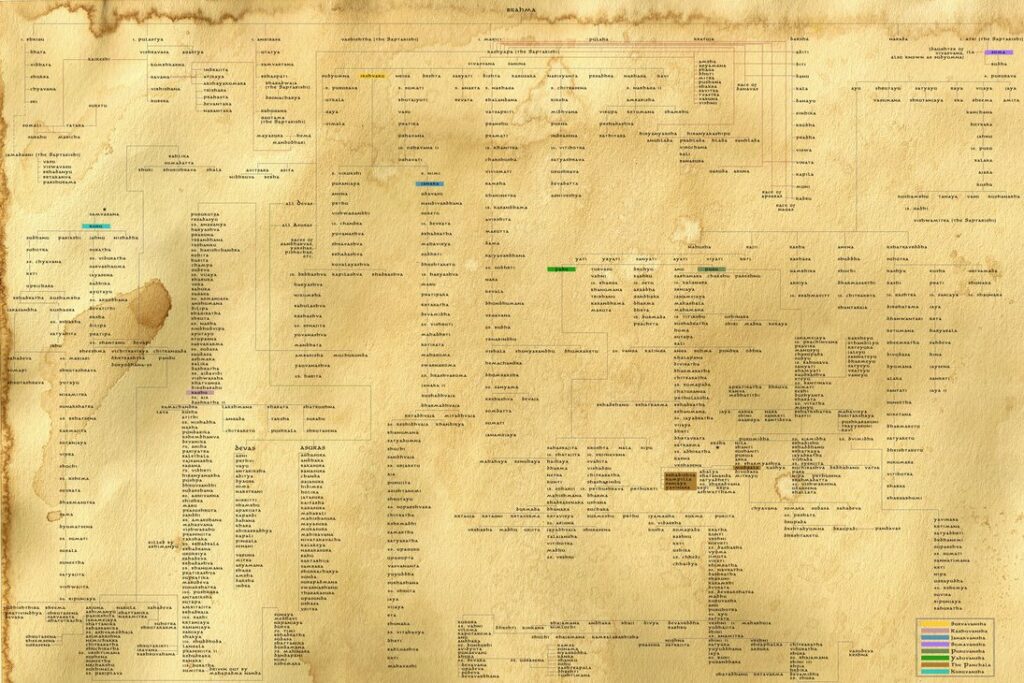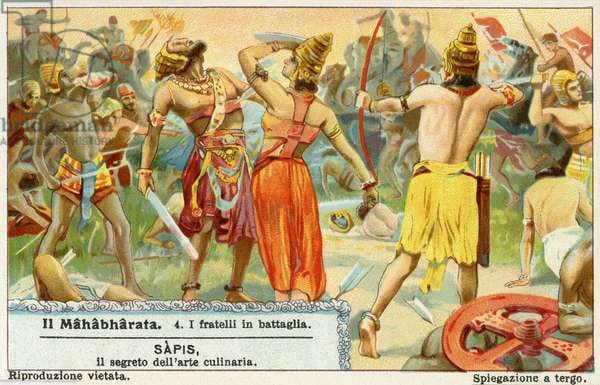
Note: In the previous post, Sauti explained the meaning of an akshauhini to the rishis. After that, he named the eighteen parvas of the Mahabharata along with the main stories and incidents described in them.
The following words are spoken by Sauti to Saunaka Kulapati (the rishi whose yagna all the other rishis had assembled to attend in Naimisha forest).
O Saunaka, this best of narrations called (Maha)Bharata that I am telling you about right now, was formerly repeated by an intelligent disciple of Vyasa at a sacrifice ordained by King Janamejaya.
Every story in this world depends upon the Mahabharata just like the human body depends on the feet. This epic poetry, which speaks of the highest wisdom, is greatly cherished by all the poets. The wonderful sections of this poem are full of subtle meaning and contain the wisdom of the Vedas. This history, called the (Maha)Bharata provides us with the knowledge of the Brahman.
Now, I will tell you about the various sections that constitute this narrative.
Note: The following sub-parvas are from the Adi Parva, which is the 1st parva of The Mahabharata.
The first few parvas of the Adi Parva are:
- Anukramanika Parva.
- Sangraha Parva.
- Paushya Parva.
- Pauloma Parva.
- Astika Parva.
Among these, the Paushya, Pauloma, and Astika parvas, describe the valor and fame of various kings. These parvas are filled with wonderful words and descriptions. They contain information about various rites and mannerisms.
Note: Next, Sauti mentions other sub-parvas, of the Adi Parva.
- Adivansavatarana Parva.
- Sambhava Parva (containing wonderful and thrilling incidents).
- Jatugrihadaha Parve (in which the house of lac is set on fire).
- Hidimbabadha Parva (the killing of Hidimba).
- Baka-badha Parva (slaying of Bakasura).
- Chitraratha Parva.
- Swayamvara (Draupadi’s swayamvara).
- Vaivahika Parva (Draupadi’s marriage).
- Viduragamana Parva (advent of Vidura).
- Rajyalabha Parva (where the Pandavas acquire the Khandavaprastha region for their kingdom).
- Arjuna-banavasa Parva (exile of Arjuna).
- Subhadra-harana Parva (the carrying away of Subhadra by Arjuna).
- Harana-harika Parva.
- Khandava-daha Parva (the burning of the Khandava forest).
- Maya-darsana (meeting with Maya the asura architect).
Note: The following sub-parvas belong to the Sabha Parva (which is the 2nd parva of The Mahabharata).
- Sabhakriya Parva.
- Mantra Parva.
- Jarasandha Parva.
- Digvijaya Parva.
- Raja-suyaka Parva.
- Arghyaviharana Parva.
- Sisupala-badha Parva (the slaying of Sisupala).
- Dyuta Parva (the game of dive).
- Anudyuta (what happened after the game of dice).
Note: The following sub-parvas belong to the Vana Parva (which is the 3rd parva of The Mahabharata).
- Aranyaka Parva.
- Krimira-badha Parva (destruction of Krimira).
- Arjuna-vigamana Parva (the travels of Arjuna).
- Kairati Parva (describes the battle between Arjuna and Mahadeva who appeared in the guise of a hunter).
- Indra-lokavigamana (Arjuna’s journey to the regions of Indra).
- Nalopakhyana (the story of Nala).
- Tirtha-yatra Parva (the pilgrimage of the wise prince of the Kurus).
- Yaksha-yudha Parva (the death of Jatasura, and the battle of the Yakshas).
- Nivata-kavacha-yudha Parva.
- Ajagara Parva.
- Markandeya-Samasya Parva (meeting with Markandeya).
- Draupadi Satyabhama Samvada Parva (Meeting of Draupadi and Satyabhama).
- Ghoshayatra Parva.
- Mirga-Swapna (dream of the deer).
- Then the story of Brihadaranyaka and then Aindradrumna.
- Draupadi-harana Parva (the abduction of Draupadi).
- Jayadratha-bimoksana Parva (the release of Jayadratha).
- Then the story of Savitri that illustrates the great merit of chastity.
- The story of Rama.
- Kundala-harana Parva (the theft of the ear-rings).
- Aranya Parva.
Hunaman from Ramayana makes an appearance in the Mahabharata too! He meets Bhima when the latter is on a search for the Saugandhika flower Draupadi wants. Hanuman is Bhima’s older brother as they share the same father, Vayu Deva.
Note: The Vairata parva which is the 4th parva of the Mahabharata describes the stay of the Pandavas, in disguise, for a year in King Virata’s palace. It contains the following stories.
- The entry of the Pandavas and the fulfillment of their promise to live in disguise for a year without being recognized by anyone.
- The destruction of the Kichakas.
- The Kauravas’ attempt to take King Virata’s cows.
- The marriage of Abhimanyu with the daughter of King Virata.
Note: Next comes the Udyoga Parva, which is the 5th parva in the Mahabharata. It consists of the following stories.
- Sanjaya-yana Parva (the arrival of Sanjaya).
- The sleeplessness of Dhritarashtra due owing to his anxiety.
- Sanatsujata Parva, which contains the mysteries of spiritual philosophy.
- Yanasaddhi Parva.
- The arrival of Krishna and the Bhagawat-yana Parva follows. This contains the stories of Matali, Galava, Savitri, Vamadeva, and Vainya, Jamadagnya and Shodasarajika.
- Bidulaputrasasana.
- Both sides muster their troops.
- The story of Sheta.
- The quarrel of the high-souled Karna.
- Troops of both sides march to the battlefield of Kurukshetra.
- Among the various soldiers, the Rathis and Atirathas are numbered.
- Duryodhana sends Uluka with a message to the Pandava camp, which angers the latter.
- The story of Amba.
- Bhishma is named the commander-in-chief of the Kaurava army.
Note: The 6th parva of the Mahabharata is the Bhishma Parva. It consists of the following stories.
- The creation of the region of Jambu, Bhumi, and the account of the formation of islands.
- The ‘Bhagavat Gita.
- The death of Bhishma.
It is in Bhishma Parva that Krishna shared the Bhagavad Gita with Arjuna and encouraged him to fight the Kurukshetra War.
Note: The 7th parva is the Drona Parva. Following are the stories included in this parva.
- The installation of Drona.
- The destruction of the Sansaptakas.
- The death of Abhimanyu.
- The vow of Arjuna to slay Jayadratha.
- The death of Jayadratha.
- The death of Ghatotkacha.
- The death of Drona.
- The discharge of the Narayana astra.
Note: The 8th parva of the Mahabharata is the Karna Parva. Kisari Mohan Ganguli’s translation simply names this parva without going into any details.
Note: The 9th parva of the Mahabharata is the Salya Parva. It contains the following stories.
- Duryodhan immerses himself in a lake.
- The encounter between Bhima and Duryodhana.
- Saraswata Parva.
- Descriptions of holy shrines.
- Description of various genealogies.
Note: The Sauptika parva (which is the 10th parva) contains disgraceful incidents performed by the Kauravas after the war was over. This refers to the remaining Pandava soldiers being killed when they were sleeping and the wounding of the embryo in Uttara’s womb by Ashwathaman.
Note: The 11th parva is the Stri Parva. It contains the following incidents.
- Jalapradana: the oblations of water to the manes of the deceased.
- The wailings of the women because of the destruction and grief caused by the war.
- Sraddha: describing the funeral rites performed for the slain Kauravas.
Note: The 12th parva is the Shanti Parva. It contains the following incidents.
- The destruction of the Rakshasa Charvaka who tried to deceive Yudhishthira in the guise of a brahmana.
- The coronation of the wise Yudhishthira.
- Grihapravibhaga Parva.
- Rajadharmanusasana Parva.
- Apaddharma Parva.
- Mokshadharma Parva.
- After these come the discussions known as Suka-prasna-abhigamana, Brahma-prasnanusana.
- An explanation of the origin of Sage Durvasa.
- The dispute with Maya asura.
The next parva (the 13th parva) is the Anusasanika. It contains the incident of the ascension of Bhishma to heaven, followed by several other discussions.
The 14th parva is the Ashwamedhika Parva. It contains the story of Yudhishthira’s horse ceremony and the Anugita – which are words of spiritual importance.
The 15th parva is the Ashramvasa Parva. It contains an account of the Pandavas’ meeting with the spirits of their deceased sons, followed by the arrival of Narada.
The 16th parva is the Mausala Parva. It is filled with cruel and terrible incidents (such as the death of Sri Krishna, Balarama, and the infighting within the Yadava race).
The next parva is the Mahaprasthanika Parva which describes the journey of the Pandavas to heaven. This is the 17th parva.
Finally, comes the Purana called Khilvansa. It contains Vishnuparva (Vishnu’s frolics and feats as a child), the destruction of Kansa, and the very wonderful Bhavishyaparva (in which there are prophecies regarding the future).
The high-souled Vyasa, composed 300 parvas and organized them into 18 sections (also called parvas). The above is a brief outline of the same.
Previous: The Meaning of One Akshauhini




